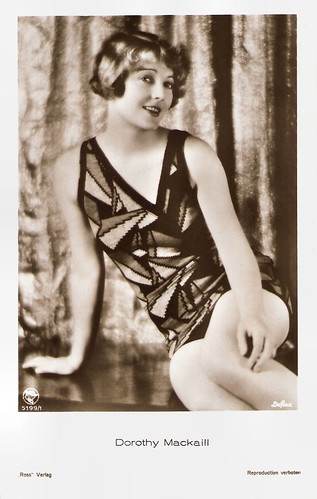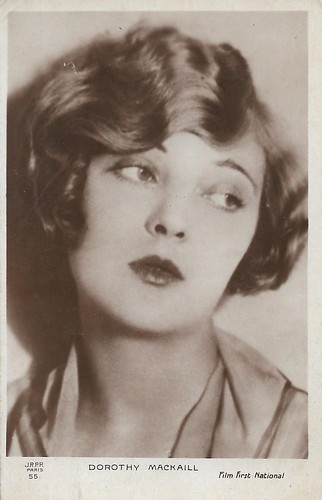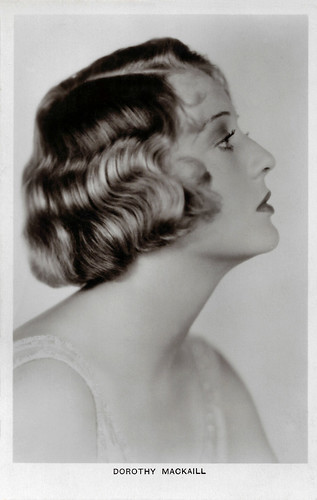
German postcard by Ross Verlag, no. 5199/1, 1930-1931. Photo: First National / Defina.

Danish postcard by J. Chr. Olsens Kunstforlag, Eneret. Photo: Milton Sills and Dorothy Mackaill (not Doris Kenyon!) in The Making of O'Malley (Lambert Hillyer, 1925).

British postcard in the Film Partners series, London, no. PC 8. Photo: Walter Byron and Dorothy Mackaill The Reckless Hour (John Francis Dillon, 1931).
True Hollywood star status
Dorothy Mackaill was born in Sculcoates, Kingston upon Hull, Great Britain, in 1903. She lived with her father after her parents divorced when she was about 11 years old. A rebellious teenager, Dorothy ran away to London, hoping to launch a show business career. Finally, she persuaded her father to pay for her board and lessons.
At age 16, she danced in Joybelles at London's Hippodrome and worked in Paris acting in a few minor Pathé films. She met a Broadway choreographer who got her a job with Ziegfield Follies in New York City. She joined the Broadway cast of 'The Century Revue' (1920). By then, she had begun the transition from Follies Girl to film actress.
That same year she appeared in her first film, the mystery The Face at the Window (Wilfred Noy, 1920). The following year, she appeared opposite Anna May Wong, Noah Beery and Lon Chaney in the drama Bits of Life (Marshall Neilan, 1921).
In the following years, her popularity increased and she starred opposite popular actors such as Richard Barthelmess and John Barrymore. In 1924, she was chosen as one of the WAMPAS Baby Stars of the Year for being an up-and-coming young actress. She reached true Hollywood star status with her role in the film The Man Who Came Back (Emmett J. Flynn, 1924) with George O'Brien.
Other successful films included Chickie (John Francis Dillon, 1925), Joanna (Edwin Carewe, 1925), and The Dancer of Paris (Alfred Santell, 1926) with Conway Tearle. In 1926 she became a naturalised American citizen. She starred in romantic drama films as well as comedies, but many of the silent films she starred in have been lost. Two of her sound films have also been lost, The Love Racket (William A. Seiter, 1929) and Strictly Modern (William A. Seiter, 1930) with Sidney Blackmer.

Belgian postcard by Weekblad Cinéma, Antwerpen.

British postcard by Film Weekly, London.

French postcard by J.R.P.R., no. 55. Photo: Films First National.
A sort of celebrity in residence in Honolulu
Dorothy Mackaill made a smooth transition to sound film in 1928. Her silent film The Barker (George Fitzmaurice, 1928) with Milton Sills, was remade as a partial talkie. In the early 1930s, her singing and dancing talents from her Ziegfeld past showed in such films as Bright Lights (Michael Curtiz, 1930). One of her most successful sound films was The Office Wife (Lloyd Bacon, 1930) in which the 35 years older Lewis Stone was her romantic interest. In the melodrama Safe in Hell (William A. Wellman, 1931), she played a prostitute who sacrifices her life for the man she loves. The film ran into trouble with the censor.
The industry was in upheaval during that transitional period, and First National didn't renew Dorothy's contract when it expired in 1931. As a freelancer, she made some good films at Columbia such as Love Affair (Thornton Freeland, 1932) with a young, clean-cut Humphrey Bogart, Paramount such as No Man of Her Own (Wesley Ruggles, 1932) with Clark Gable and Carole Lombard, and MGM such as The Chief (Charles Reisner, 1933) with Ed Wynn, but overall her career was idling.
The following year brought few prospects, and she wound up making a trio of quickies for the independent market, a particularly poor example being Cheaters (Phil Rosen, 1934) with William Bendix for low-rent Liberty Pictures. She returned to Great Britain for her last film, the espionage thriller Bulldog Drummond at Bay (Norman Lee, 1937) starring John Lodge. After that, she retired from the film world and took care of her invalid mother.
In 1955, she moved to Honolulu, Hawaii. She had fallen in love with the islands while filming His Captive Woman (George Fitzmaurice, 1929) and had made eight radio programs about the hotel. Mackaill lived at the luxurious Royal Hawaiian Hotel on the beach at Waikiki as a sort of celebrity in residence and enjoyed swimming in the ocean nearly every day. In 1976 and 1980, she guest starred in the TV series Hawaii Five-O.
She died of kidney (or liver ) failure in 1990 in her room at the Royal Hawaiian Hotel. Mackaill was married three times. Her first marriage to German-born actor, film director and screenwriter Lothar Mendes lasted from 1926 to 1928. Her second marriage to radio singer Neil Albert Miller lasted from 1931 to 1934. She was married to horticulturist Harold Patterson from 1947 to 1948. All of the marriages ended in a divorce and she had no children. She was cremated and her ashes were scattered off Waikiki Beach.

British postcard in the Film Partners series, London, no. P 8. Photo: Walter Byron and Dorothy Mackaill in The Reckless Hour (John Francis Dillon, 1931).

British postcard in the Picturegoer Series, London, no. 188a.

British postcard in the Picturegoer Series, London, no. 188c.
Sources: Hal Erickson (AllMovie), Linda Davis (Find A Grave), Cliff Aliperti (Immortal Ephemera), Wikipedia (Dutch, German and English) and IMDb.
No comments:
Post a Comment